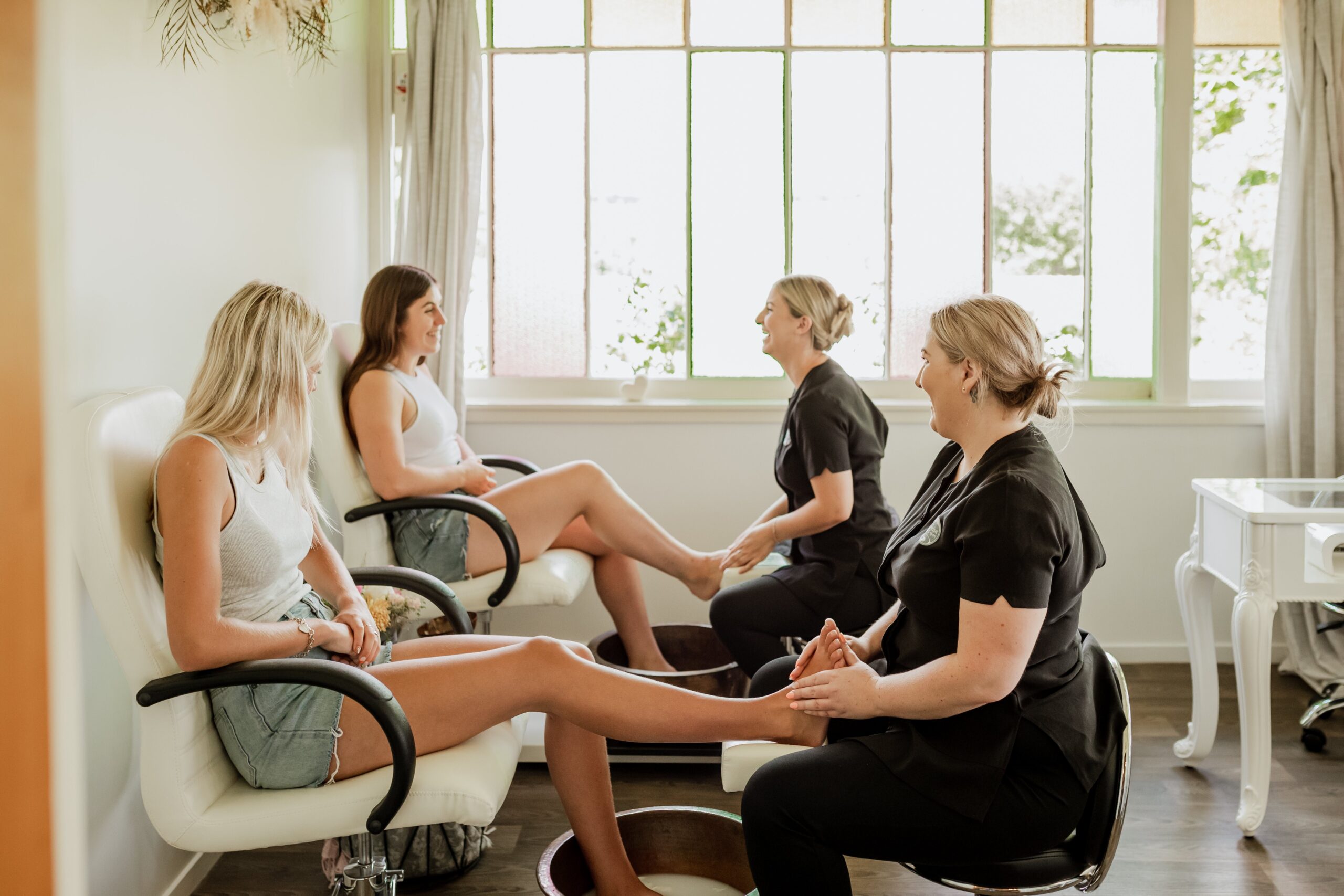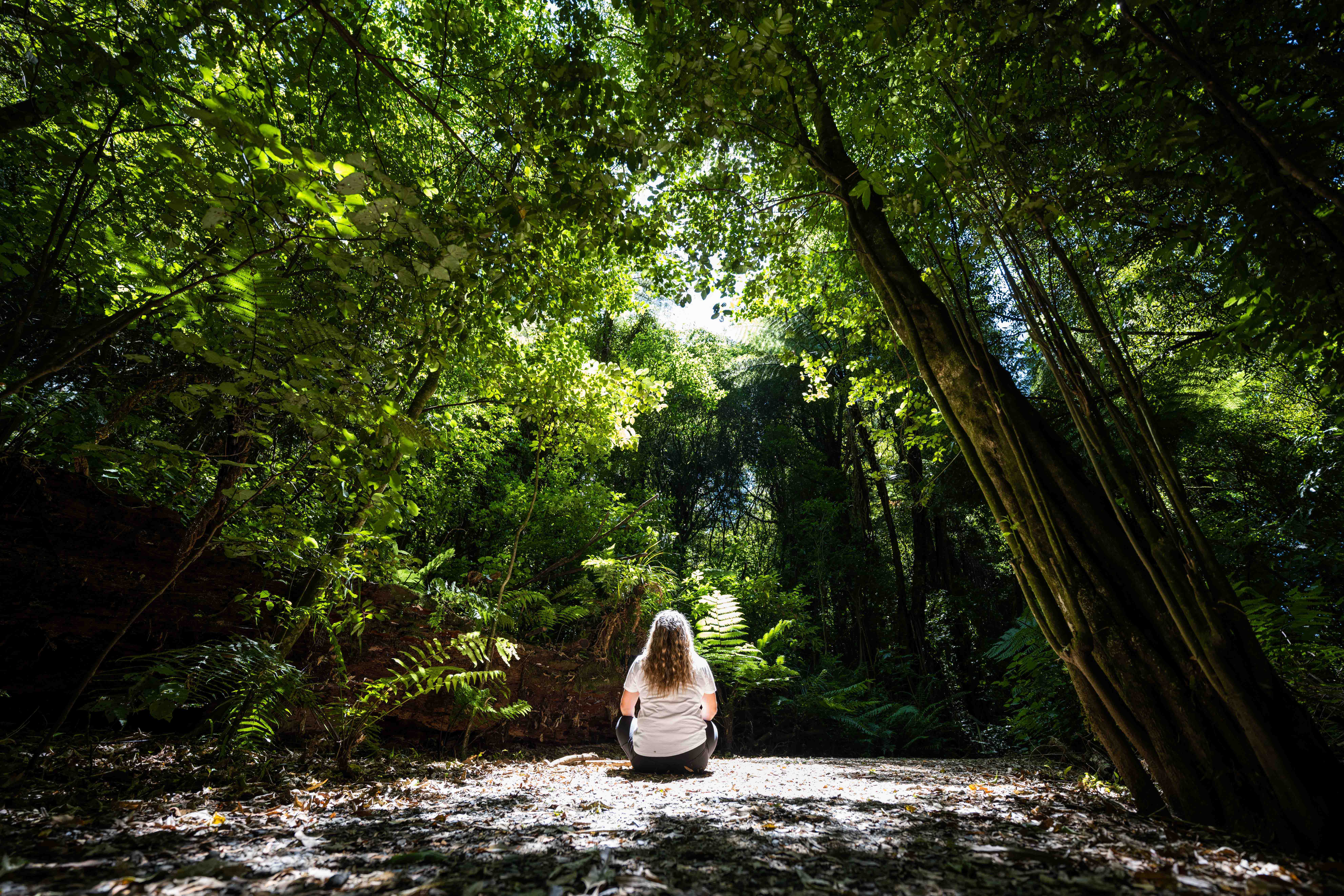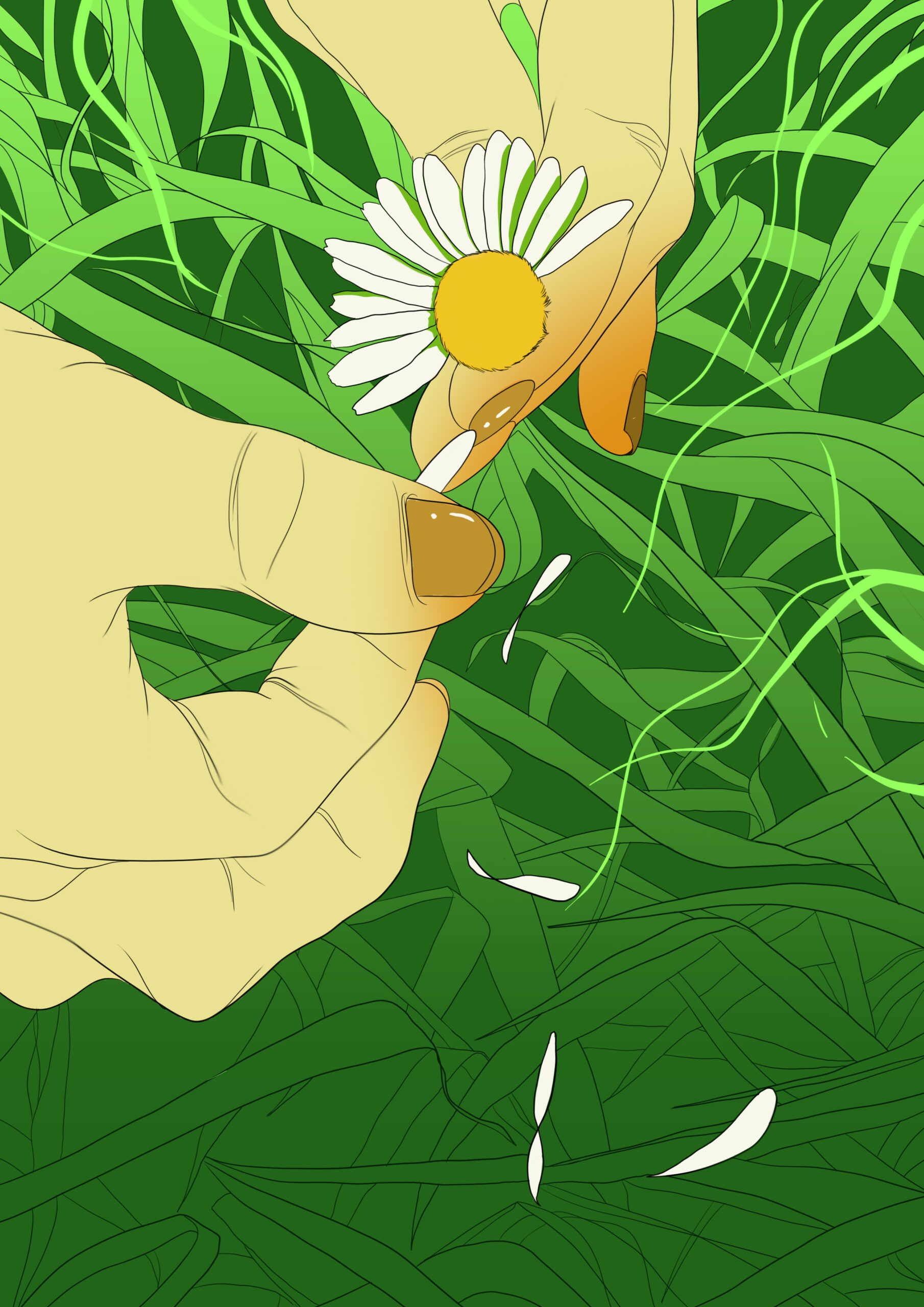Finding sanctuary at Sanctuary Mountain
One of the few stands of ancient forest left in New Zealand, Sanctuary Mountain Maungatautari in Waikato is so special that kākāpō are set to be released here in 2023. It will be the first time the endangered parrots have been moved back onto the mainland by DOC and Ngāi Tahu, and the dense forest and habitat on the maunga is perfect for these beautiful birds. The environment is also perfect for humans seeking a reset in nature.
Recently the Sanctuary has added wellness tours including a rongoā rākau Māori medicine tour, meditation at the maunga, tree lore and forest bathing. These came out of a survey which looked at the wellbeing effects of connecting people to pure nature, and will be running until the end of March.
The rongoā rākau tour focuses on identifying native plants on the maunga that have different medicinal purposes.
Tree lore explores myths about trees in different cultures, learning why they’re worshipped across the planet and spending time amongst the tawa forest. And of course don’t forget the forest bathing sessions.
“We’re calling it a summer of wellness,” says Sanctuary Mountain Maungatautari marketing manager Monique Webb.
Self-guided tours are also popular, where you can buy a day pass, pack a picnic and wander at your own leisure along five kilometres of gravelled walking tracks through the forest and access a viewing tower at its centre.
Summer is also a good time to visit the Sanctuary’s purpose-built ‘tuatararium’, as the tuataras like to sunbathe on the rocks, and you might see the endangered takahē here too. The Sanctuary has a growing number of endangered birds thriving in its environment, including the shy kōkako, while its population of Western Brown kiwis has grown to close to 2,000. And while you are not guaranteed to always see these rare birds, you might be lucky enough to hear them.
“It’s about all of your senses, not just what you visually see but what you hear as well,” explains Webb. “It’s about taking the time to stop and listen as well.”
sanctuarymountain.co.nz

Self-love in Te Aroha
Sheltered at the base of Te Aroha Mountain, the historic town of Te Aroha is making a comeback after the heady days of it being the spa town du jour from the late 1890s to the 1930s.
It’s home to what is believed to be the only hot bicarbonate of soda geyser in the Southern Hemisphere and where the Mokena geyser – which erupts every 40 minutes – continues to replenish the Te Aroha Mineral Spas with mineral water.
Greatly valued by Māori who bathed in them for leisure as well as to restore health or soothe battle wounds, and later enjoyed by weary gold miners, Te Aroha Mineral Spas became a leading attraction for tourists and those seeking health treatments. At its opening in 1898, Te Aroha’s Cadman bathhouse was described as the best-appointed bathhouse of its type in the Southern Hemisphere and included smart tiled corridors and 19 top-of-the-range porcelain slipper baths. Today at Te Aroha you can relax and unwind in beautiful private wooden tubs (minimum two adults per spa).
Unlike hot water bathing in Rotorua, you don’t need to shower afterwards. In fact, it’s recommended not to.
“We don’t have sulphur in our water so it doesn’t smell or ruin jewellery,” says Aimee Davies, Matamata-Piako District Council tourism manager. “We advise people not to shower after their spa because it will wash all that beautiful mineral water off.”
A spa in the sparkling alkaline waters was traditionally a precursor to a massage, as the water left the skin silky and ideal for manipulation. Now, it’s still recommended to head for a massage post-soak, at Domain House Beauty (14 Wilson Street; a historic building) a short walk away.
Te Aroha was chosen as a place to develop a spa industry because of the hot springs at the foot of the mountain and the mountain’s classic shape. Famous spas in Europe were often associated with mountains. Most recently, the maunga has again been a drawcard, as the location chosen to film New Zealand/Ireland co-production The Gone. During filming, the cast and crew were regulars at the Te Aroha Mineral Spas.
The restoration of the spa facility over the years has seen the recent resurrection of Number Two bathhouse, the oldest bathhouse in New Zealand, and the building of a leisure pool complex.
There’s one hot spring accessible to everyone, even if it is only to dip your toes – a welcome treat for tired feet, especially if you’ve summited Mt Te Aroha and back.
Several walking trails and mountain biking tracks lead from behind the spa building, where you can also catch the geyser if you get the timing right.
You should allow two to three hours to the Mt Te Aroha summit, while shorter walks include ambles around the Domain and to the top of Tutumangaeo Waterfall.
You can also walk the Heritage Trail – Te Aroha, which takes in the town’s historic buildings. Pick up a map at the local information centre or Te Aroha District Museum (tearoha-museum.com) in the Domain and while you are there, watch the entertaining 15-minute DVD presentation of the spa’s history!
tearohamineralspas.co.nz

Behind the scenes at HobbitonTM Movie Set
Airbnb fans lucky enough to secure a limited overnight stay opportunity will be descending on Hobbiton during the first three weeks of March.
The stays are part of the 10th anniversary celebrations of The Hobbit: An Unexpected Journey. But celebrations aside, the picturesque pastures of Middle-earth are worth a visit anytime and you may be heartened to learn that your visitor footprint at Hobbiton is being taken care of behind the scenes by the Hobbiton sustainability team.
Food packaging on site is compostable and to ensure it is disposed of properly, rubbish is hand-sorted on site and cardboard put through a chipper and turned into mulch, which is then used in the gardens surrounding the Hobbit holes.
The team have also been working with Niwa to monitor the health of Hobbiton Lake, and tree planting around waterways and around Alexander Farm.
“In keeping with the original story we obviously don’t want native trees right in the middle of the set, though there are quite a few already,” says Hobbiton general manager Shayne Forrest. “During filming they didn’t want to chop the trees down so they wrapped them with fake English beech branches which were taken away at the end of filming.
“But in the distance, we have these pockets of forest out on Alexander Farm, and that’s what the film company loved about our location – the rolling hills and scattered tree lines – so we are putting plantings out around the wider area of the Shire.”
Hobbiton has also made the Tiaki Promise, the Tourism Industry Aotearoa 2025 Sustainability Pledge that aims to see every New Zealand tourism business committed to sustainability by 2025.
“A lot of stuff we were doing already, but it’s a fantastic initiative that gives one voice to the tourism community,” says Forrest.
Part of that is making Hobbiton accessible to local school groups to visit and also have the opportunity to meet the gardeners and visit the recycling and compost centre.
All great stuff to know when you’re enjoying the new Second Breakfast Tour, which includes a tour, breakfast beverage at The Green Dragon and breakfast banquet in the renovated Millhouse.
The four-hour Evening Banquet Tour is a feast of whole chickens, mushrooms, potatoes and lamb shanks – designed to be picked up and shared. Afterwards you get to hold a copper lantern and walk through the movie set at night. Magic!
hobbitontours.com

Three wonders of Waitomo
Did you know the Waitomo Caves visitor experience includes three caves, each with its own unique experience? Most know the Waitomo Glowworm Caves – which include a boat ride under the glowworms twinkling on the roof. Yet Ruakuri Cave is the largest cave with glowworms too, and is wheelchair-accessible. Entry is made through a man-made spiral entrance which opens up onto limestone formations and crystal tapestries. Black water rafting tours also traverse this cave if that’s your cup of tea.
Aranui Cave is the least-known of the three and doesn’t have any glowworms, but is an enchanting experience due to the cave’s spectacular sparkling brown, pink and white stalactites and stalagmites.
The caves were first explored in 1887 by local Māori chief Tāne Tinorau accompanied by English surveyor Fred Mace. The majority of the guides today are descendants of Tāne and his wife Huti.
Since that time visitors have come to Waitomo to see the caves and to ensure that the caves can be enjoyed for hundreds of years to come, the caves’ environment is monitored daily. This means you can visit safe in the knowledge that you’re not harming these taonga.
“There’s a real balancing act, a lot of science that goes on behind the scenes and part of the ticket price also helps fund the conservation mahi that we do to protect the caves,” says Discover Waitomo environmental manager Shannon Corkill.
“We do a lot with sensors and data logging to monitor all the climate conditions in the caves… We know that high levels of carbon dioxide for a sustained period of time can lead to condensation corrosion, which is the reversal or breakdown of stalactites and stalagmites, and we’ve got a number of environmental management processes in place to manage that.” waitomo.com

Best-kept secret
Waikato’s wonderful arboretum and sculpture park
An oasis nestled amongst rolling hills of Waikato pasture, the Sculpture Park at Waitakaruru Arboretum will have you exclaiming ‘WOW’ the moment you pass through its gates. Here the air smells sweeter, tranquillity and birdsong fills the air and a 2km trail on the 42-acre site peppered with carefully positioned works of art awaits. Wherever you look there’s a discovery waiting to be made. Or you may just be content to sit amongst nature and know that your $15 entry fee is helping support a phenomenal environmental project.
The Park, undoubtedly one of the most sustainable tourism destinations in New Zealand, is protected under a carbon sequestration programme and is the legacy of founders Dorothy and John Wakeling who had the foresight to rehabilitate a derelict greywacke quarry.
Dorothy’s background is environmental planning and John’s, arboriculture.
“We’ve known about climate change for 30 years and so we know the value of trees. That’s one of the reasons why we wanted to plant an arboretum,” explains Dorothy.
The couple searched for a big piece of land to rehabilitate and found what they were looking for in an old Winstones quarry, which John describes as being a “gaping wound” on the landscape.
The quarry roading had gentle gradients that curved uphill through gullies and around ridges. The main pit was the outstanding feature – vertical cliffs, steep scree slopes and a large pond made this property unique.
They made the decision not to bring in more diggers and instead work with what they had with plants. Since 1991 they have planted more than 30,000 trees (native and exotic) and recently harvested some pines that they planted on the property 27 years ago. With the proceeds from the sale of the pines they have planted a further 3,300 trees to extend an Asian forest that fans out from a lush rock garden.
No longer a barren landscape, you’ll find intimate tree-enclosed spaces, ponds filled with floating sculptures and singing frogs, small waterfalls, flora and fauna from many parts of the world, as well as a staircase leading to a Japanese-inspired folly. There’s also Australian and New Zealand sections, a fernery, an orchard and an artist’s shelter.
The couple felt it was a wonderful setting for sculptures, and the Park is now hosting its 25th sculpture exhibition, Stories in the Landscape 2022, until the end of February.
A map and arrows on the trail guide you round 100 sculptures. New works in the latest exhibition include ‘Māori Angels Series: Ko Au’ by Carla Ruka and ‘Tōtara Tui’ by Marcus Tatton.
Kids are well catered for at Waitakaruru Arboretum, where they can enjoy finding the roosting ruru – there are 15 ruru sculptures hidden throughout the park.
The couple still live and work on the property, which is managed by The Art-in-Nature Arboretum Trust, and the Park is open to the public seven days a week to enjoy and explore.
“Our intention is that it inspires creativity and environmental awareness in all ages,” says Dorothy.
sculpturepark.co.nz
NZ’s most personal wildlife experience
You can see kiwis close up at Ōtorohanga Kiwi House, a leading conservation tourism destination since 1971. A sanctuary for many native birds and reptiles rarely seen in the wild, it provides visitors with educational opportunities and a personal experience.
Ōtorohanga Kiwi House is home to more than 20 brown kiwis on site as part of a nationwide captive breeding programme. It is also a pre-release conditioning site for brown kiwis preparing to be released into the wild.
When the kiwis are younger, Kiwi House displays them in specially designed nocturnal enclosures where the day and night cycles have been reversed. This means visitors can see these kiwis probing for insects and earthworms in the soil, bathing in ponds, digging burrows or climbing logs during the day.
Kiwi House is also home to tuatara and a variety of New Zealand native birds including kea, whio (blue duck) and kārearea (NZ falcon). kiwihouse.org.nz






